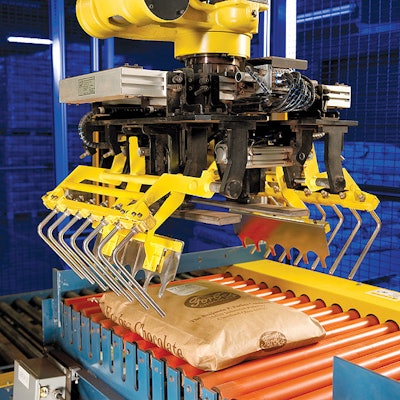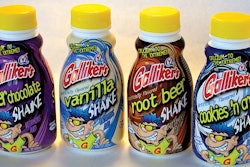Forbes Chocolate has been a fixture in Cleveland business for more than 100 years. It’s been operating in its current plant for 15 years, and its growing business as an ingredient supplier to food processors has put plant space at a premium. So when Forbes’ management looked to convert from manual to automatic palletizing, its options were as limited as its plant floorspace.
“Our operation is definitely space-challenged,” says Keith Geringer, vice president at Forbes. “The space we had available ruled out just about everything but robotic palletizers. A robot was the better fit.”
Company representatives had seen robotic palletizers demonstrated at several food expositions in recent years. So the company contacted manufacturers of palletizers before it settled on a system from Fanuc Robotics that was installed late last year. The system consists of the Model M-410iB robot, infeed conveyor, pallet accumulation conveyor, bag handling end-of-arm tooling, and Fanuc’s iPendant, the operator interface panel.
Forbes’ goal was twofold: improve its production throughput by eliminating the bottleneck of manual palletizing, and relieve employees of a tedious, heavy-lifting operation. The company’s main bagging line feeds sacks to the palletizer in weights ranging from 16 to 60 lb. Four different bag sizes and styles are filled on the line, so the palletizer and its bag-handling tool had to be able to handle a variety of sizes.
Even more important to Forbes, the company wanted the system to be installed by the end of 2003 for accounting purposes. “When we contacted Fanuc, we explained our timeline on this,” Geringer recalls. “They sent an engineer in to see our plant and take measurements. They came to us with a proposal in early October of last year. Once we agreed, they built the system, we shipped sample bags for them to test, and we had a demonstration at Fanuc’s facility.”
Forbes’ people went to the trial expecting that plant personnel would install the palletizer. Once they saw it, they decided to have Fanuc install the system at Forbes with plant personnel working alongside. “When they installed it, we worked closely with them, and they showed us everything we needed to understand to operate it,” Geringer says. In fact, he says, no one from the plant has yet undergone formal training on it, although Forbes’ plant manager will probably receive advanced training this winter.
“Operating the system is so easy even I can do it,” Geringer quips.
The requirements
The variety of bag sizes and two sizes of pallets complicated the plans for the palletizer, says Steve LaMarre, the Fanuc sales representative. For example, the pneumatic cylinder that pushes an empty pallet into the loading position was engineered and built to contact only the wood pallet. That’s because when the pallet is staged by the operator, a corrugated tray is set up and stapled to the pallet. The tray has sidewalls that are about 6” high, so it could be damaged if the positioning cylinder came into contact with it.
The plant ships loads on both standard Grocery Manufacturers of America 48”x40” pallet sizes and European pallets that are a bit smaller. So the dimensions of the tray provide the “target” for robotic loading.
The robot is a high-speed, four-axis robot designed for palletizing. It’s the 160-kg version that’s the lightest version of three sizes, but LaMarre calls it “perfectly adequate” for this application. The mechanical bag-handling tool has what Fanuc calls “adjustable whips,” but LaMarre says that the sizes of Forbes bags are similar enough not to require adjustment.
“What helped seal our proposal with Forbes,” says LaMarre, “is that we have another customer in the area that also buys multiwall bags from Forbes’ supplier. Their reference about our equipment and service really helped us.”
How system works
In the Forbes operation, the palletizer operator simply uses the iPendant to program the robot for the bag size and product being filled, along with the desired load pattern for the customer. In addition, LaMarre says, there are some controls on the front of the controller that can be used for initiating a cycle, for example, but the iPendant is the primary control system.
Forbes’ packaging line delivers the packages through a bag flattener and then a metal detector toward the palletizer. Just before entering the robotic work cell, bags pass a label applicator from Loveshaw that applies a product identification label to the bags, which are preprinted with the Forbes Chocolate brand name. This print-and-apply labeler identifies each bag with item number, product name, usage rate, and ingredients statement, Geringer says. For some bags, bar codes are also printed onto these labels. The labeled bag is delivered by Forbes’ belt conveyor to the infeed of the palletizer, which consists of a roller conveyor.
The infeed conveyor is very short, so Fanuc didn’t have to worry about conveying characteristics too much, LaMarre says. It holds just a few bags, he says, so the bags don’t have a chance to distort their shapes. Sensors then alert the robotic head when a bag reaches the pick-up point. Roller spacing and side rails were designed for smooth transfer while providing access for pickup by the robotic head.
Earlier, the operator has staged an empty pallet with its corrugated tray, and the system carries the pallet into proper loading position, after being alerted by a push-button. Once it’s clamped in position, the robotic head then picks up the bag and transfers it into position on the pallet, repeating the process until the pallet pattern is completed. The tool employs three motions: two used to square and grip the bag and another to prevent any movement during transfer.
At this point, the controller initiates the transfer of the pallet out of the robotic work cell to a pickup position where it can be removed by a forklift.
Advance programming
With the test loads that were supplied to Fanuc, the supplier was able to create the two-part software that operates the system. The first part, which is on a separate computer, is software called Pallet Pro. This three-dimensional software is actually a simulation package, where the complete flow is programmed through icons, including how the system will operate and the pallet patterns to be used.
The second part is the software called Pallet Tool, for the robotic controller that calibrates and controls the robotic functions on the iPendant. Based on the information contained in Pallet Pro, it generates the specific robot programming. In addition, says LaMarre, Fanuc added some extra prompts to this software, specific to the Forbes application.
There is also a changeover function key, in case Forbes needs to add a new location or make any sensor changes. This will also allow Forbes to add any additional pallet patterns that might be requested by a new customer. Most of Forbes’ patterns are the interlocked “five-tie,” says Geringer.
The software had to consider both the GMA and European pallet sizes. “Because we import 90% of our cocoa on these pallets, we needed to use them for outgoing loads,” Geringer says. “These pallets are not only a bit smaller than GMA pallets, but they don’t have the same runners, so they must go into the palletizer in a different way.”
After palletizing, the loads are stretch wrapped on existing equipment that uses a film cover over the top of the load.
The benefits to Forbes
The primary benefit to Forbes is in output. “Even though our production increase isn’t spectacular, our rates are now much faster than a person could safely do,” Geringer says. “And there is room for future growth, because we’re nowhere near the 25 bags-per-minute capacity of the robot. Palletizing is no longer a bottleneck. Now the speed constraint on the line is our bagging operation.”
In addition, Forbes can now build taller pallet loads, sometimes as high as seven feet. “When we were palletizing manually, there were limits on how high a worker could throw a bag weighing up to 60 pounds,” says Geringer. “Now we can stack higher, so we use fewer pallets. Even more important, we save on shipping costs, since a lot of our shipments go at a pallet rate, regardless of whether the pallet holds 500 or 2귔 pounds. This way we can save our customers some money.”
He adds that the loads are much more consistent and straight, but Geringer can’t point to any reaction from customers. “No complaints is like a compliment,” he says. He adds that damage claims have also been reduced, but he declined to disclose any specifics.
Payback on the equipment is also something that Forbes can’t discuss, except to say that the previous workers who built pallet loads are a lot happier. “We didn’t lay anyone off by adding this machine, but we sure use our workers more effectively,” says Geringer. “Before, we had to rotate workers in manually building pallet loads because the work was so tiring. That’s why our people bought into this new system so enthusiastically. I can tell you that one back injury to a worker would more than offset the cost of the palletizer.” The new palletizer is also proving to be a focal point when customers visit the Forbes plant.
Plus, it’s also restored Forbes’ faith in new equipment. “A couple of years ago, we had a real bad experience with some new equipment, so we were almost gun-shy about doing this,” says Geringer. “For this project, the Fanuc people were great to work with, and their service has been terrific.”






























